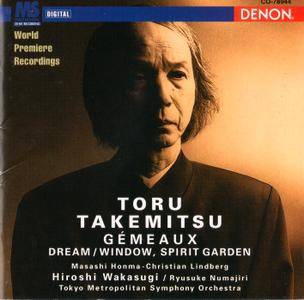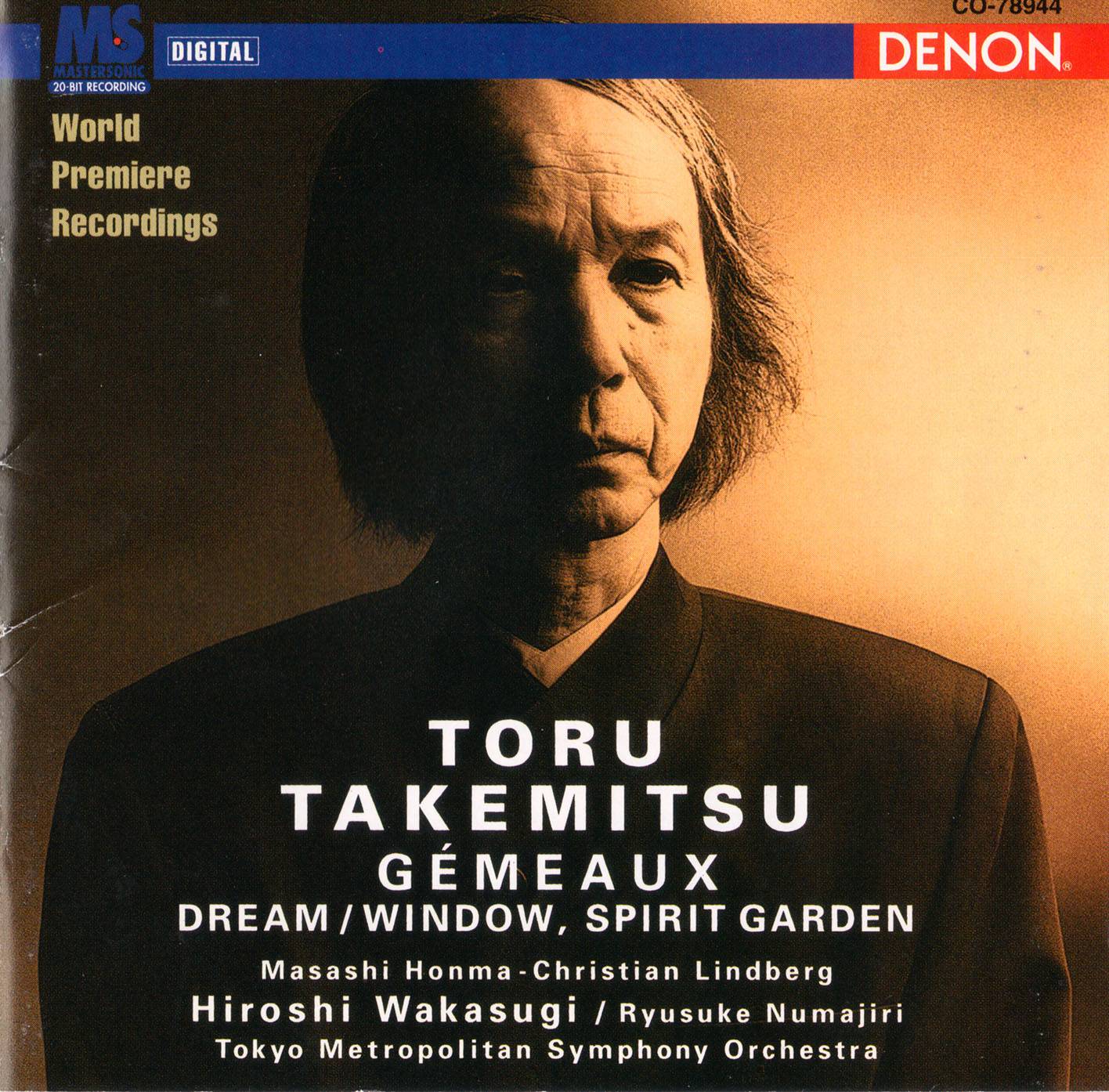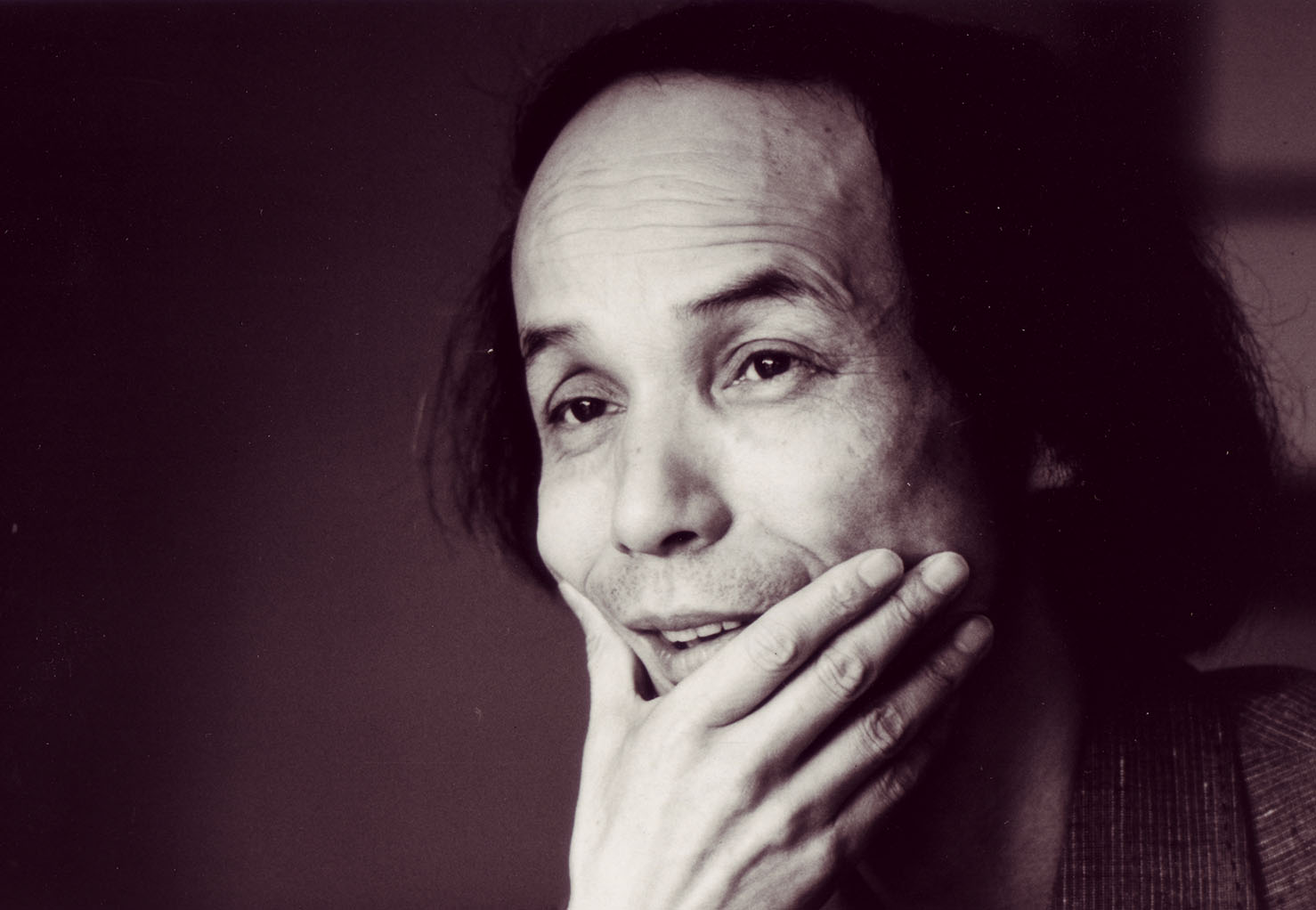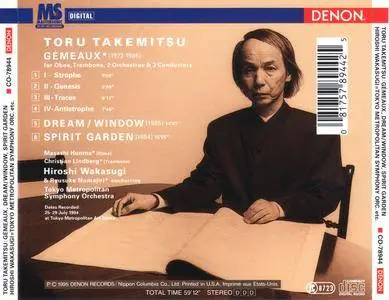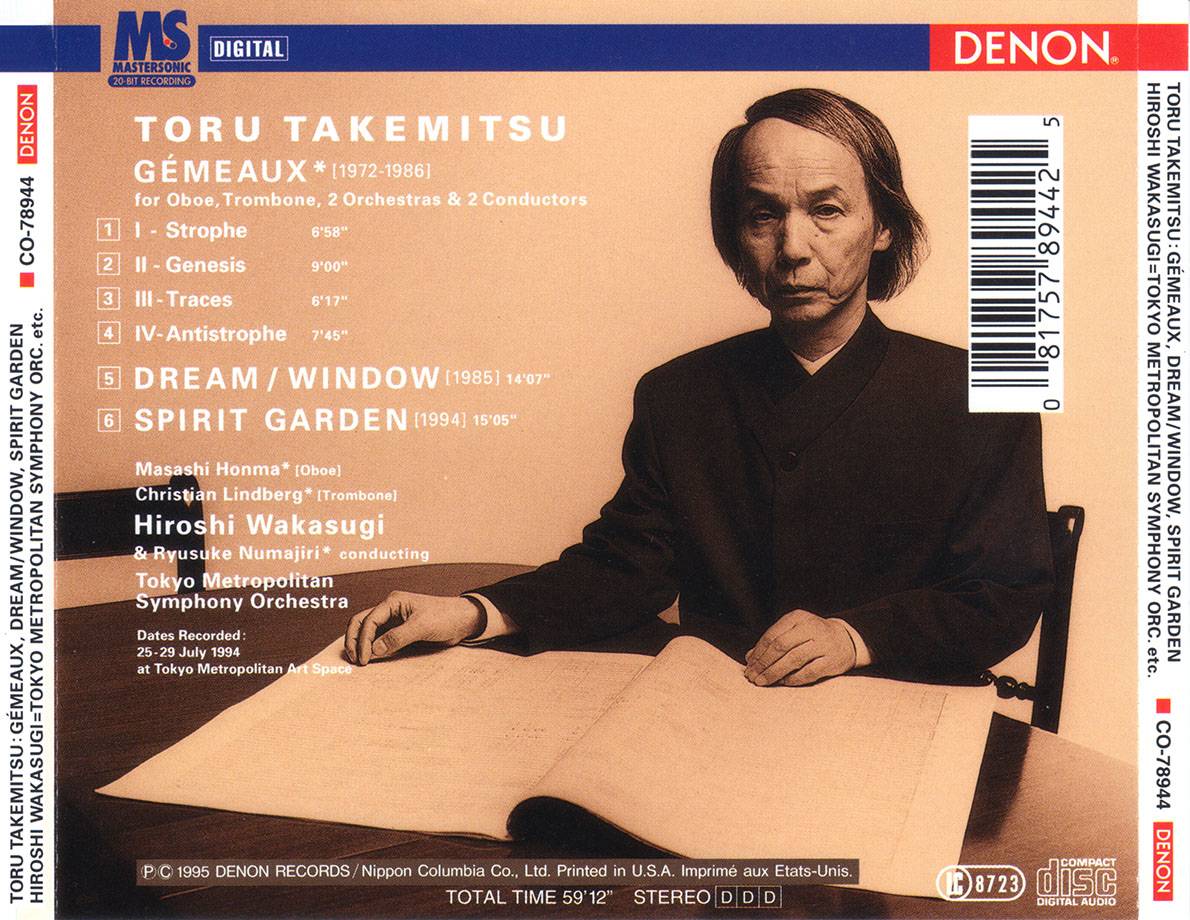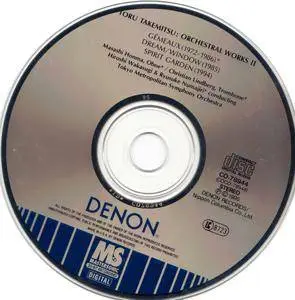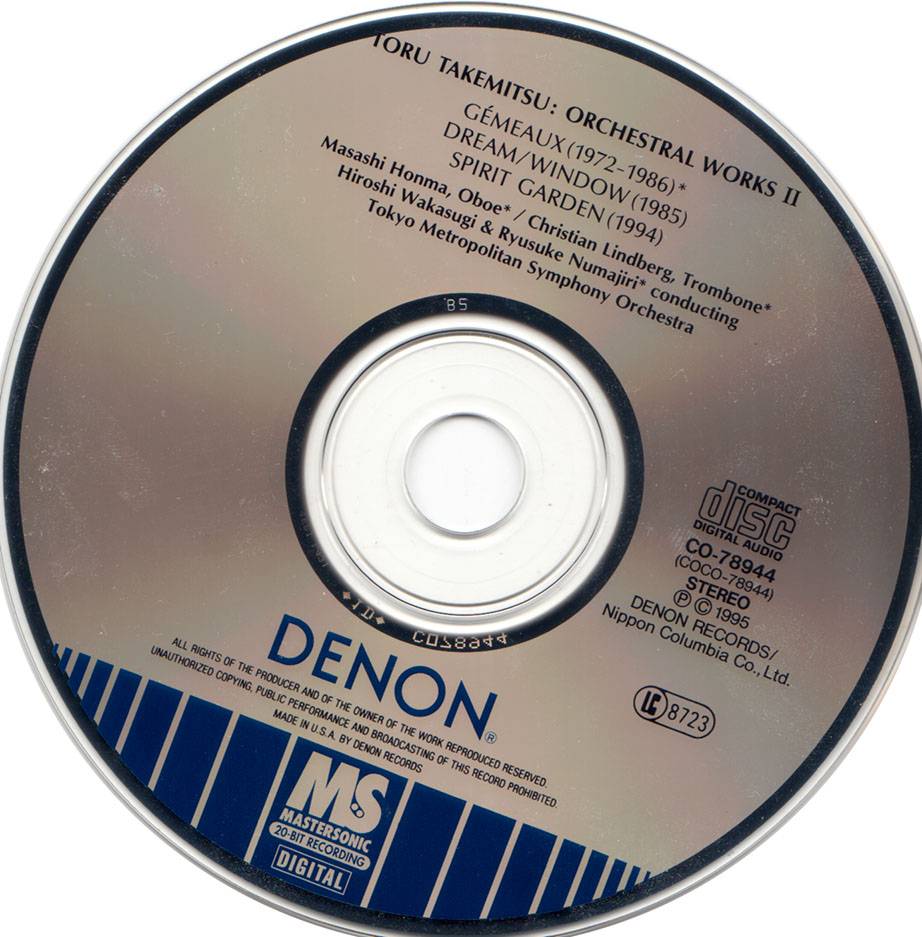Toru Takemitsu - Orchestral Works II: Gémeaux; Dream/Window; Spirit Garden (1995)
Tokyo Metropolitan Symphony Orchestra; Hiroshi Wakasugi, Ryusuke Numajiri
Masashi Honma, oboe; Christian Lindberg, trombone
EAC | FLAC | Tracks (Cue&Log) ~ 253 Mb | Mp3 (CBR320) ~ 137 Mb | Scans ~ 58 Mb
Classical, Contemporaty | Label: Denon | # CO-78944 | Time: 00:59:52
Tokyo Metropolitan Symphony Orchestra; Hiroshi Wakasugi, Ryusuke Numajiri
Masashi Honma, oboe; Christian Lindberg, trombone
EAC | FLAC | Tracks (Cue&Log) ~ 253 Mb | Mp3 (CBR320) ~ 137 Mb | Scans ~ 58 Mb
Classical, Contemporaty | Label: Denon | # CO-78944 | Time: 00:59:52
"Gemeaux" (1971-1986) is one of Takemitsu's grandest works in terms of musical arc, scoring and length of gestation. It is written for two orchestras with two conductors, and with solo trombone at one orchestra and solo oboe at the other. As half of it was written during Takemitsu's "modernist apogee" of the turn of the '70s, we find a host of extended techniques, and at one point the soloists even speak through the mouthpieces of their instruments. As the other half of the work belongs to Takemitsu's late period, we find a successful of elegant self-contained gestures, his musical "gardens". The synthesis of two creative periods, however, makes for a piece singular in its impact in Takemitsu's oeuvre. I've heard "Gemeaux" called a love song, but whatever it is, the dialogue between the soloists and their orchestras is mesmerising, and the huge crescendo at the end (unique in Takemitsu's output) is possibly the greatest close of an orchestral work I've ever heard.
The other two pieces on the disc are from Takemitsu's late period, You might read that they both happen to show some interest in twelve-tone serialism, but don't let that scare you away. Though Takemitsu had a great interest in numerology and pitch class wizardry, the result is writing much in keeping with his interest in a serene and ordered soundscape. "Dream/Window" (1985) and "Spirit Garden" (1994) are among the most varied of Takemitsu's late works, and the former is my favourite of this era. The performances here work much better than Knussen's reading of "Dream/Window" on a Deutsche Grammophon disc or Alsop's reading of "Spirit Garden" on Naxos.Review by Christopher Culver, Amazon.com
COMPOSER'S NOTES:
GÉMEAUX for oboe, trombone, two orchestras and two conductors
Commenced in 1971, Gémeaux was conceived as a work for two orchestras located spatially apart from one another, with Heinz Holliger and Vinko Globokar as the respective oboe and trombone soloists. The work consists of the following four sections:
1 Strophe
2 Genesis
3 Traces
4 Antistrophe.
As suggested by the title, the notion of the number 'two' pervades the work. There is also considerable influence from an excerpt from a poem by Shuzo Takiguchi entitled Handmade Proverbs:
Your eyes, your hands, your breasts…
You are twins in yourself.
The music is more a large‑scale collection of chamber works than an orchestral work and requires of each performer an extremely high level of virtuosity. It is a love story set to music depicting the plight of two beings who sometimes come into conflict with one another but who, through love, become one.
DREAM/WINDOW for orchestra
The title Dreaml/Window is taken from the Buddhist name of a Zen priest of the Muromachi Period, Muso (mu=dream, so=window) Soseki (1275‑1351). Among the many famous gardens designed by Muso Soseki is that of the Saihoji Temple (popularly known as the 'Moss Temple') in Kyoto. My music has been profoundly influenced by Japanese historic gardens. For example, Arc for piano and orchestra (1963‑66/76) and In an Autumn Garden in the complete version for gagaku orchestra (1979) were based on relatively concrete images of gardens.
How was I to describe Kyoto through this music? To transform Muso Soseki's moss‑covered temple gardens into music is to grasp but an extremely small part of this complex urban space. In Kyoto a progressive tendency coexists with an entrenched conservatism, concealing a dynamism different from that of Tokyo or Osaka. Beneath the hushed serenity of Kyoto, the gears of change grind on and on without cease. At the core of my image of Kyoto is this struggle of such opposing tendencies. The name 'Muso' (i.e. Dream Window) seemed the perfect symbol for this struggle.
I use 'dream' and 'window' as metaphors for the two contradictory dynamisms of facing inwards and outwards. To make the inner and the outer resound simultaneously is the prime object of the music. Accordingly, it was necessary to alter the arrangement of the orchestra from the standard. A small ensemble (flute, clarinet and string quartet) is placed between the right and left string sections at the centre front. Yet this piece is not a concerto. This small ensemble is not only one part of the entire orchestra but also a microcosm symbolising an orchestra in and of itself. One might even call it an inner self. At the centre of the orchestra, four instruments (two harps, celesta and guitar) create a passageway of clear timbre as an intermediary between the outer and the inner. The brass, woodwind and percussion sections are positioned at the centre rear. The form of this music resembles that of a dream. While the details are clearly defined, their arrangement is left up to the fortuities of the self‑propelling narrative. While repeating itself and revealing itself in a seemingly incoherent manner like the fragments of a dream, the musical sequence gradually forms itself into a tonal image with D as the primary note.
SPIRIT GARDEN for orchestra
Spirit Garden was commissioned by the Hida Furukawa International Music Festival and so named as a metaphor for the sacred ground, endowed with an inviolable dignity, of the festival's home, Furukawacho, in Gifu Prefecture. At the same time, the title is intimately connected to the structure of the work.
The work is based on a twelve‑note row from which three chords each of four notes are generated. These chords, accompanied by changes in tone colour (sometimes expanded, sometimes contracted), are an ever‑present undercurrent, vibrating at the fundamental, from which a musical garden is composed.
The 'objects' of sound placed about the garden ‑ in some cases the 'object' is the melody, in other cases it is fragments serving as the tone colour structure ‑ are all derived from the basic raw material of the twelve‑note row, and aim through use of that material at achieving a cosmological (musical) unity. The 'objects' of sound placed about the garden change their forms through the changes in the angle of viewing which result from moving around the garden. Spirit Garden is not intended to be programme music. It is my experiment with and ongoing inquiry into orchestral colour and melody.Toru Takemitsu
Masashi Honma, oboe
Christian Lindberg, trombone
Tokyo Metropolitan Symphony Orchestra
conducted by
Ryusuke Numajiri (1-4)
Hiroshi Wakasugi
Recording: 25-29 July 1994, Tokyo Metropolitan Art Space.
Tracklist:
Gémeaux (1972-1986)
for Oboe, Trombone, two Orchestras and two Conductors
01. I. Strophe (7:03)
02. II. Genesis (9:03)
03. III. Traces (6:19)
04. IV. Antistrophe (7:58)
05. Dream/Window, for Orchestra (1985) (14:21)
06. Spirit Garden, for Orchestra (1994) (15:07)
Exact Audio Copy V1.1 from 23. June 2015
EAC extraction logfile from 4. July 2016, 23:18
Takemitsu, Toru / Gemeaux, Dream-Window, Spirit Garden
Used drive : PLEXTOR CD-R PREMIUM2 Adapter: 5 ID: 1
Read mode : Secure
Utilize accurate stream : Yes
Defeat audio cache : Yes
Make use of C2 pointers : No
Read offset correction : 30
Overread into Lead-In and Lead-Out : Yes
Fill up missing offset samples with silence : Yes
Delete leading and trailing silent blocks : No
Null samples used in CRC calculations : Yes
Used interface : Installed external ASPI interface
Gap handling : Appended to previous track
Used output format : User Defined Encoder
Selected bitrate : 896 kBit/s
Quality : High
Add ID3 tag : No
Command line compressor : C:\Program Files\Exact Audio Copy\Flac\flac.exe
Additional command line options : -6 -V -T "ARTIST=%artist%" -T "TITLE=%title%" -T "ALBUM=%albumtitle%" -T "DATE=%year%" -T "PERFORMER=%albuminterpret%" -T "TRACKNUMBER=%tracknr%" -T "TOTALTRACKS=%numtracks%" -T "GENRE=%genre%" -T "COMPOSER=%composer%" -T "ALBUMARTIST=%albumartist%" -T "ALBUM ARTIST=%albumartist%" -T "COMMENT=EAC Secure Mode, Test & Copy, AccurateRip, FLAC -6" %source%
TOC of the extracted CD
Track | Start | Length | Start sector | End sector
––––––––––––––––––––––––––––-
1 | 0:00.00 | 7:02.73 | 0 | 31722
2 | 7:02.73 | 9:03.17 | 31723 | 72464
3 | 16:06.15 | 6:19.13 | 72465 | 100902
4 | 22:25.28 | 7:57.72 | 100903 | 136749
5 | 30:23.25 | 14:20.63 | 136750 | 201312
6 | 44:44.13 | 15:07.37 | 201313 | 269374
Track 1
Filename D:\EAC extraction\01 - Gemeaux - I. Strophe.wav
Pre-gap length 0:00:02.00
Peak level 73.4 %
Extraction speed 1.9 X
Track quality 99.9 %
Test CRC 65A88A36
Copy CRC 65A88A36
Accurately ripped (confidence 2) [D51C2BFD] (AR v1)
Copy OK
Track 2
Filename D:\EAC extraction\02 - Gemeaux - II. Genesis.wav
Peak level 72.1 %
Extraction speed 1.9 X
Track quality 100.0 %
Test CRC 510D12D3
Copy CRC 510D12D3
Accurately ripped (confidence 2) [9AD100D4] (AR v1)
Copy OK
Track 3
Filename D:\EAC extraction\03 - Gemeaux - III. Traces.wav
Peak level 57.9 %
Extraction speed 1.9 X
Track quality 100.0 %
Test CRC B404FBA7
Copy CRC B404FBA7
Accurately ripped (confidence 2) [2AD5F766] (AR v1)
Copy OK
Track 4
Filename D:\EAC extraction\04 - Gemeaux - IV. Antistrophe.wav
Peak level 97.7 %
Extraction speed 1.9 X
Track quality 100.0 %
Test CRC 5EAAB1BA
Copy CRC 5EAAB1BA
Accurately ripped (confidence 2) [E0B66D1F] (AR v1)
Copy OK
Track 5
Filename D:\EAC extraction\05 - Dream-Window.wav
Pre-gap length 0:00:09.00
Peak level 80.2 %
Extraction speed 1.9 X
Track quality 99.9 %
Test CRC 4CB7B6EC
Copy CRC 4CB7B6EC
Accurately ripped (confidence 2) [A66BCFB0] (AR v1)
Copy OK
Track 6
Filename D:\EAC extraction\06 - Spirit Garden.wav
Pre-gap length 0:00:10.00
Peak level 53.8 %
Extraction speed 1.9 X
Track quality 100.0 %
Test CRC 91A65FA0
Copy CRC 91A65FA0
Accurately ripped (confidence 2) [48D96F08] (AR v1)
Copy OK
All tracks accurately ripped
No errors occurred
End of status report
–– CUETools DB Plugin V2.1.6
[CTDB TOCID: p4QKXpjX85xghxwUQ9R.ApWF9Oo-] found
Submit result: p4QKXpjX85xghxwUQ9R.ApWF9Oo- has been confirmed
Track | CTDB Status
1 | (21/21) Accurately ripped
2 | (21/21) Accurately ripped
3 | (21/21) Accurately ripped
4 | (21/21) Accurately ripped
5 | (21/21) Accurately ripped
6 | (21/21) Accurately ripped
==== Log checksum 64676A703960ED4A0D9FED7B8DE9EC2836BDC08F23C6116932EFE23EF863F718 ====
EAC extraction logfile from 4. July 2016, 23:18
Takemitsu, Toru / Gemeaux, Dream-Window, Spirit Garden
Used drive : PLEXTOR CD-R PREMIUM2 Adapter: 5 ID: 1
Read mode : Secure
Utilize accurate stream : Yes
Defeat audio cache : Yes
Make use of C2 pointers : No
Read offset correction : 30
Overread into Lead-In and Lead-Out : Yes
Fill up missing offset samples with silence : Yes
Delete leading and trailing silent blocks : No
Null samples used in CRC calculations : Yes
Used interface : Installed external ASPI interface
Gap handling : Appended to previous track
Used output format : User Defined Encoder
Selected bitrate : 896 kBit/s
Quality : High
Add ID3 tag : No
Command line compressor : C:\Program Files\Exact Audio Copy\Flac\flac.exe
Additional command line options : -6 -V -T "ARTIST=%artist%" -T "TITLE=%title%" -T "ALBUM=%albumtitle%" -T "DATE=%year%" -T "PERFORMER=%albuminterpret%" -T "TRACKNUMBER=%tracknr%" -T "TOTALTRACKS=%numtracks%" -T "GENRE=%genre%" -T "COMPOSER=%composer%" -T "ALBUMARTIST=%albumartist%" -T "ALBUM ARTIST=%albumartist%" -T "COMMENT=EAC Secure Mode, Test & Copy, AccurateRip, FLAC -6" %source%
TOC of the extracted CD
Track | Start | Length | Start sector | End sector
––––––––––––––––––––––––––––-
1 | 0:00.00 | 7:02.73 | 0 | 31722
2 | 7:02.73 | 9:03.17 | 31723 | 72464
3 | 16:06.15 | 6:19.13 | 72465 | 100902
4 | 22:25.28 | 7:57.72 | 100903 | 136749
5 | 30:23.25 | 14:20.63 | 136750 | 201312
6 | 44:44.13 | 15:07.37 | 201313 | 269374
Track 1
Filename D:\EAC extraction\01 - Gemeaux - I. Strophe.wav
Pre-gap length 0:00:02.00
Peak level 73.4 %
Extraction speed 1.9 X
Track quality 99.9 %
Test CRC 65A88A36
Copy CRC 65A88A36
Accurately ripped (confidence 2) [D51C2BFD] (AR v1)
Copy OK
Track 2
Filename D:\EAC extraction\02 - Gemeaux - II. Genesis.wav
Peak level 72.1 %
Extraction speed 1.9 X
Track quality 100.0 %
Test CRC 510D12D3
Copy CRC 510D12D3
Accurately ripped (confidence 2) [9AD100D4] (AR v1)
Copy OK
Track 3
Filename D:\EAC extraction\03 - Gemeaux - III. Traces.wav
Peak level 57.9 %
Extraction speed 1.9 X
Track quality 100.0 %
Test CRC B404FBA7
Copy CRC B404FBA7
Accurately ripped (confidence 2) [2AD5F766] (AR v1)
Copy OK
Track 4
Filename D:\EAC extraction\04 - Gemeaux - IV. Antistrophe.wav
Peak level 97.7 %
Extraction speed 1.9 X
Track quality 100.0 %
Test CRC 5EAAB1BA
Copy CRC 5EAAB1BA
Accurately ripped (confidence 2) [E0B66D1F] (AR v1)
Copy OK
Track 5
Filename D:\EAC extraction\05 - Dream-Window.wav
Pre-gap length 0:00:09.00
Peak level 80.2 %
Extraction speed 1.9 X
Track quality 99.9 %
Test CRC 4CB7B6EC
Copy CRC 4CB7B6EC
Accurately ripped (confidence 2) [A66BCFB0] (AR v1)
Copy OK
Track 6
Filename D:\EAC extraction\06 - Spirit Garden.wav
Pre-gap length 0:00:10.00
Peak level 53.8 %
Extraction speed 1.9 X
Track quality 100.0 %
Test CRC 91A65FA0
Copy CRC 91A65FA0
Accurately ripped (confidence 2) [48D96F08] (AR v1)
Copy OK
All tracks accurately ripped
No errors occurred
End of status report
–– CUETools DB Plugin V2.1.6
[CTDB TOCID: p4QKXpjX85xghxwUQ9R.ApWF9Oo-] found
Submit result: p4QKXpjX85xghxwUQ9R.ApWF9Oo- has been confirmed
Track | CTDB Status
1 | (21/21) Accurately ripped
2 | (21/21) Accurately ripped
3 | (21/21) Accurately ripped
4 | (21/21) Accurately ripped
5 | (21/21) Accurately ripped
6 | (21/21) Accurately ripped
==== Log checksum 64676A703960ED4A0D9FED7B8DE9EC2836BDC08F23C6116932EFE23EF863F718 ====
foobar2000 1.2 / Dynamic Range Meter 1.1.1
log date: 2017-07-14 01:48:02
––––––––––––––––––––––––––––––––––––––––
Analyzed: Takemitsu, Toru / Gémeaux • Dream/Window • Spirit Garden
––––––––––––––––––––––––––––––––––––––––
DR Peak RMS Duration Track
––––––––––––––––––––––––––––––––––––––––
DR14 -2.68 dB -26.48 dB 7:03 01-Gémeaux - I. Strophe
DR18 -2.83 dB -26.95 dB 9:03 02-Gémeaux - II. Genesis
DR16 -4.74 dB -28.77 dB 6:19 03-Gémeaux - III. Traces
DR17 -0.20 dB -23.56 dB 7:58 04-Gémeaux - IV. Antistrophe
DR19 -1.91 dB -27.89 dB 14:21 05-Dream/Window
DR16 -5.37 dB -27.61 dB 15:07 06-Spirit Garden
––––––––––––––––––––––––––––––––––––––––
Number of tracks: 6
Official DR value: DR17
Samplerate: 44100 Hz
Channels: 2
Bits per sample: 16
Bitrate: 573 kbps
Codec: FLAC
================================================================================
log date: 2017-07-14 01:48:02
––––––––––––––––––––––––––––––––––––––––
Analyzed: Takemitsu, Toru / Gémeaux • Dream/Window • Spirit Garden
––––––––––––––––––––––––––––––––––––––––
DR Peak RMS Duration Track
––––––––––––––––––––––––––––––––––––––––
DR14 -2.68 dB -26.48 dB 7:03 01-Gémeaux - I. Strophe
DR18 -2.83 dB -26.95 dB 9:03 02-Gémeaux - II. Genesis
DR16 -4.74 dB -28.77 dB 6:19 03-Gémeaux - III. Traces
DR17 -0.20 dB -23.56 dB 7:58 04-Gémeaux - IV. Antistrophe
DR19 -1.91 dB -27.89 dB 14:21 05-Dream/Window
DR16 -5.37 dB -27.61 dB 15:07 06-Spirit Garden
––––––––––––––––––––––––––––––––––––––––
Number of tracks: 6
Official DR value: DR17
Samplerate: 44100 Hz
Channels: 2
Bits per sample: 16
Bitrate: 573 kbps
Codec: FLAC
================================================================================
All thanks to original releaser - quivive
More interesting music in My Blog
More interesting music in My Blog
This CD was recorded with pre-emphasis; the cuesheet to the extracted CD contains 'FLAGS PRE' tags. If you don't want to change the audio data permanently (in order to maintain an identical 1:1 copy) use the cue-sheet and EAC with its own writing engine (not CDRDAO) to burn the disc.
For correct playback with foobar2000 install the De-emphasis postprocessor (foo_deemph) component.
For correct playback with foobar2000 install the De-emphasis postprocessor (foo_deemph) component.


